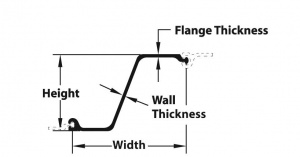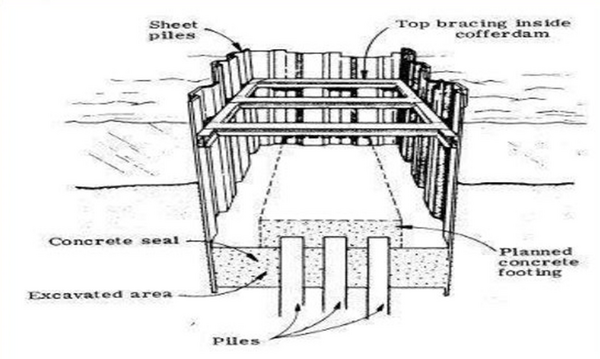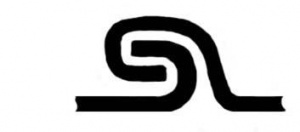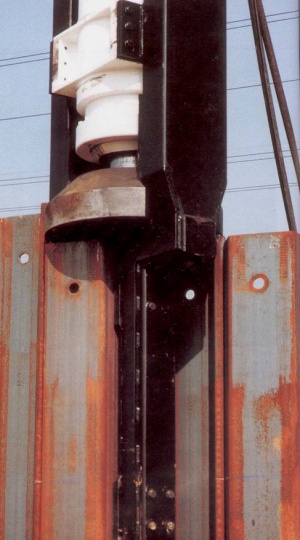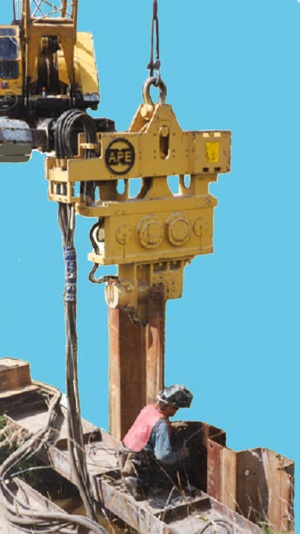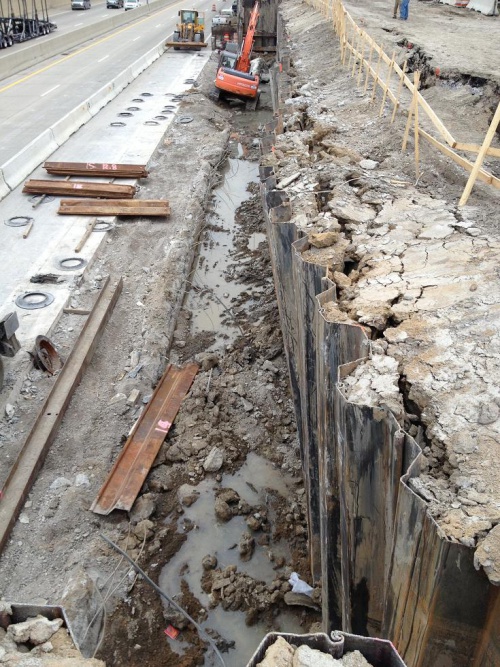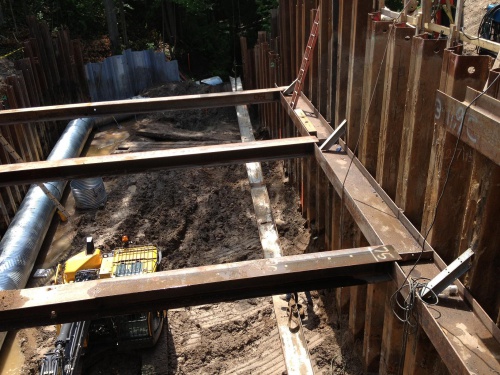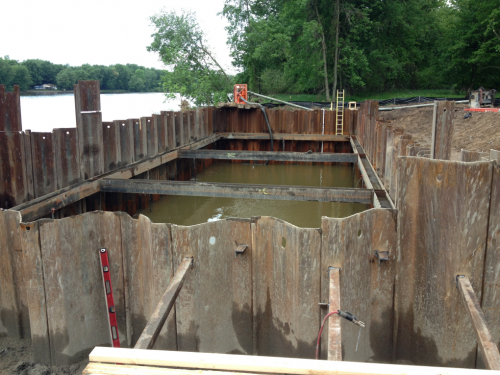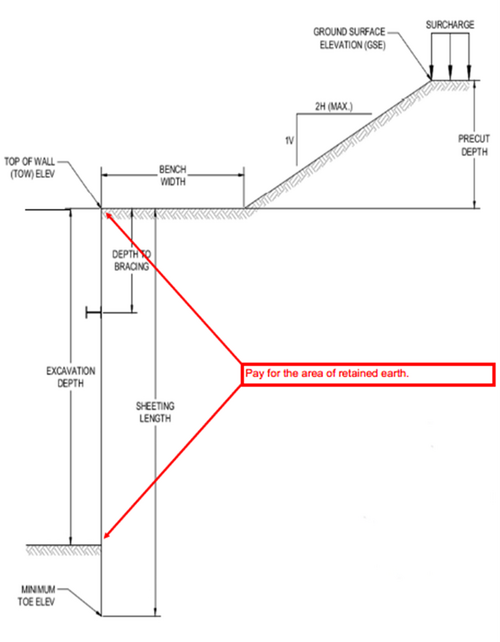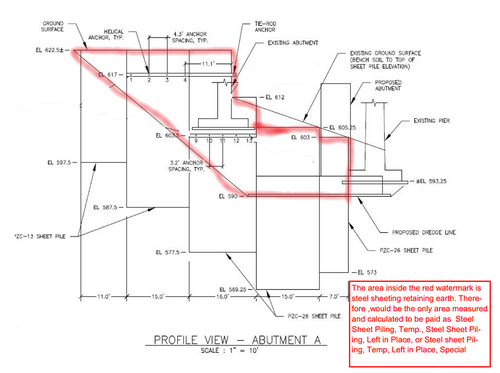704 - Steel Sheet Piling and Cofferdams
GENERAL DESCRIPTION
Steel sheet piling may be permanent, temporary, or temporarily left in place, meaning the sheeting was designed to support earth pressures during staged construction, and removal of the sheeting may be detrimental to permanent structures. Sheeting may also be part of a cofferdam, along with other structural components such as bracing, struts, walers, tie backs, and other related structural components act to create a watertight seal, as to construct substructure elements in the dry.
MATERIALS
Steel sheeting consists of new or used continuous interlock-type steel sections including connections and corner pieces. Steel sheet piling can resist loads via cantilever capacity, or in combination with bracing such as walers and struts.
Used steel sheet piling must be in good condition, and its use must be approved by the Engineer prior to driving.
The most common steel sheet piling shapes are the PZ types. For example, for a PZ-27 section, the P stands for “pile” the Z is for the “type or shape”, and 27 represents the unit weight per ft2 of material. Figure 704-1 shows a typical PZ shape configuration.
Permanent Steel Sheet Piling
The permanent steel sheet piling minimum nominal section modulus, material grade, and all other pertinent information will be shown on the plans.
Permanent steel sheet piling will be furnished with suitable connections and corner pieces. The inside face is to be located along the footing outline. Cold rolled sheeting will be permitted as long asif the sheeting has an equivalent sectional modulus that meets the minimum requirements. Check the plans to see if permanent steel sheet piling is required to be hot dipped galvanized and ensure the steel sheet piling sections brought to the site meet this requirement. Mill Test certifications and Buy America/Build America certifications are required for all permanent steel sheet piling.
Temporary Steel Sheet Piling & Temporary Steel Sheet Piling Left In Place
The Contractor’s plans must show the required embedment depths, steel material grades, connection, and weld details, along with required bracing, walers, tie backs and other related structural components. Mill Test certifications and Buy America/Build America certifications are required for all temporary steel sheet piling left in place. General certifications are required for temporary steel sheet piling. General certifications can be in the form of manufacturer’s catalog cuts identifying the sections being used.
Ensure all structural materials required to construct temporary steel sheet piling meets or exceeds the material requirements as specified in the Contractor’s design. The following should be checked at a minimum:
- Steel sheet piling size designation and section modulus – i.e. PZ-22 or greater (section modulus must be at least 18.1 in3/ft of wall) Sometimes the contract plans will specify a minimum section modulus.
- Size and designation of any other structural components, such as bracing, struts or walers – typically HP or W shapes
- Material grade of steel – AASHTO M 270 Grade 36 (A36), Grade 50, or Grade 50W as required in subsection 906.06.B of the Standard Specifications for Construction
- Welded connections – typically fillet welds are used to connect bracings and other structural members to the steel sheet piling, with 1/4” being the minimum weld size required per table 707-1 of the Standard Specifications for Construction
Ensure the Contractor has provided new or used continuous interlock type steel sheet piling including connection and corner pieces. Used steel sheet piling must be in good condition, and its use must be approved by the Engineer prior to driving.
Cofferdams - Cofferdams Left In Place
A cofferdam is a substantially watertight enclosure consisting of steel sheet piling and structural bracing components which will permit substructure construction in waterways, or other areas where the construction must be isolated from the surroundings. Steel sheet piling is part of the overall structural system resisting earth and hydraulic pressures. Some cofferdams may require bracing, struts, walers, tie backs and dead men to maintain acceptable stresses on the members.
Ensure all structural materials required to construct temporary steel sheet piling meet or exceed the material requirements as specified in the Contractor’s design plans. The following should be checked at a minimum:
- Steel sheet piling size designation and section modulus – i.e. PZ-22 or greater (section modulus must be at least 18.1 in3/ft of wall)
- Size, span lengths and designation of any other structural components, such as bracing, struts or walers – typically HP or W shapes (see Figure below).
- Type of tie-back or ground anchor, if any, and testing requirements for lock off forces
- Material grade of steel – AASHTO M 270 Grade 36 (A36), Grade 50, or Grade 50W as required in subsection 906.06.B of the Standard Specifications for Construction.
- Welded connections – typically fillet welds are used to connect bracings and other structural members to the steel sheet piling, with 1/4" being the minimum weld size required per table 707-1 of the Standard Specifications for Construction.
- Weld electrode of E70XX
Grade 3500 concrete will be used according to Standard Specifications for Construction Table 1004-1 in subsection 1004 and note (g) 3- to 7-inch slump for tremie applications without admixture or with Type A or D admixture or (i) 3- to 8-inch slump for tremie applications after the addition of Type F or G admixture.
Ensure the concrete has attained at least 50 percent of the 28-day compressive strength, or after test beams break with a modulus of rupture of at least 325 psi prior to dewatering. M ill Test certifications and Buy America/Build America certifications are required for all cofferdams left in place. General certifications are required for cofferdams. General certifications can be in the form of manufacturer’s catalog cuts identifying the sections being used.
Steel Sheet Piling Section Fabrication
Hot rolled sections provide and excellent interlock seal that works well against water seepage through the interlock. A ball and socket type interlock is common for hot rolled sections. This interlock is durable and ideal for repeated use. See Figure 704-3 below for the ball and socket type interlock. Hot rolled sections are typically more expensive, and thus, not used as frequently by contractors for temporary left in place applications.
Cold rolled sections are more common for temporary left in place applications due the fact they can be cut to any length or quantity and are less expensive to produce than hot rolled sections. A hook and grip type interlock is common for cold rolled sections, which are known for allowing seepage through the interlock, and may become brittle over time due to the cold forming process. See Figure 704-4 below for the hook and grip type interlock. Pay close attention to interlocks getting jammed easily from soil, and water seepage in their final position.
EQUIPMENT
-Reserved-
PRECONSTRUCTION
Design
All steel sheet piling designs are done in accordance with the AASHTO Standard Specification for Highway Bridges, 17th edition, the MDOT Bridge Design Manual, and the specifics as shown in the contract plans and specifications.
Permanent steel sheet piling details are included in the contract plans and should have a familiar look and feel with respect to the MDOT plan format. Typically, these designs are completed, or approved by Geotechnical Services prior to inclusion in the final plans. The required steel sheet piling sections, embedment depths and section, elevations, and material grades will be shown on the contract plans and specifications.
Temporary steel sheet piling, and cofferdams will be conceptually shown on the plans with respect to rough plan and section views, but this is for bidding purposes only, and not based on detailed analysis or design. The Contractor is responsible for the design of the temporary steel sheeting and cofferdam installations. The design is based on the substructure size, staging requirements, soil boring information, and other geotechnical information as shown in the contract plans and specifications.
At locations where the combined depth of retained water or soil is less than 6 feet, the Contractor is to submit the temporary steel sheeting piling, and cofferdam working drawings for approval. The drawings are to be stamped by a licensed Engineer per subsection 104.02 of the Standard Specifications for Construction.
At locations where the combined depth of retained water or soil is greater than 6 feet, the Contractor is to submit the temporary steel sheeting piling, and cofferdam working drawings and design calculations for approval per subsection 104.02 of the Standard Specifications for Construction.
The MDOT Geotechnical Services Section and Bridge Field Services areas will review the temporary steel sheet piling and cofferdam designs for conformance to the appropriate geotechnical and structural requirements. When reviewing the Contractor’s temporary steel sheet piling and cofferdam working drawings and calculations, the following must be shown:
- Steel sheet piling section modulus – must be at least 18.1 in3/ft of wall when adjacent to traffic
- Design methodology for bracing, struts, walers, welded or bolted connections, and other structural components, i.e. AISC Allowable Stress, AISC LRFD, etc.
- Design methodology for tie backs, deadmen, ground anchors, or other externally applied anchor supports, i.e. FHWA Publication No. FHWA-IF-99-015 (Geotechnical Engineering Circular No. 4, Ground Anchors and Anchored System)
- Embedment depths, toe information, and depth of earth retained.
- Material grade of steel for all structural members.
- Other than the anticipated earth pressures and the 360 psf live load surcharge (when stage line is adjacent to traffic), consideration of any temporary loads such as construction equipment, anticipated material stockpiles, and unbalanced hydrostatic pressures.
- Overall plan view or temporary steel sheet piling and cofferdam installations documenting each stage of construction, with profile and cross section views to ensure all load cases are accounted for, and the system can be built as intended.
Working drawings for temporary steel sheet piling and cofferdams will typically not follow the MDOT plan format, as they are developed by the Contractor. Temporary steel sheet piling details will not be included on the contract plans, other than general limits, locations, and cut off elevations shown in plan and section views typically as part of staged construction. The Contractor is responsible for designing, providing, installing, maintaining, and removing temporary steel sheet piling, or cutting off temporary steel sheet piling left in place to the elevations as shown on the plans. Sheeting may be driven to the penetration as determined by the Contractor’s approved design unless otherwise noted by the design plans (i.e., the plans may specify a penetration depth regardless of the design).
Take the time to review and understand the following important elements:
- Overall staging scheme, and locations of stage line sheeting
- Step by step sequence of construction for each stage
- Toe elevations per stage
- Waler and bracing elevations per stage
- Shelfing requirements during excavation
- Equipment or stockpiled material placement
Once the Contractor’s design is approved, ensure it is built according to the approved design. Any variations, material or section substitutions, or changes in loading or site conditions will require further review and approval by MDOT Geotechnical Services Section and Bridge Field Services
If there are questions at any time during the temporary steel sheet piling and cofferdam installation, please contact Geotechnical Services Section or Bridge Field Services for assistance.
Ensure all structural materials required to construct a cofferdam Left in Place steel sheet piling meet or exceed the material requirements as specified in the Contractor’s design plans. The following should be checked at a minimum:
- Top of sheeting elevations, embedment depths or refusal elevations, and bracing elevations
- Plan, section, and elevation details for each stage
- Construction sequence as it relates to driving steel sheet piling, bracing, and allowable excavation limits and elevations.
- Partial or total enclosure contains interior clearance sufficient for constructing forms and providing a safe working area.
Ensure the Contractor is constructing the cofferdam elements using the MDOT approved design plans, as it is common for Contractor cofferdam designs to go through many revisions prior to final approval.
CONSTRUCTION
Driving Steel Sheet Piles
Unless prohibited otherwise on the plans, there are two methods for driving steel sheet piling, diesel or hydraulic impact (or drop hammers), and vibratory. Where the plans indicate that a vibratory hammer is not allowed then a variable moment hammer may be used.
Diesel Impact (Drop) Hammers
Diesel impact or drop hammers consist of a lead mounted short stroke heavy ram, with a drive cap to fit on to the steel sheet piling shape. Steel sheet piling is driven via impact force from the ram. See Figure 704-5 for a typical impact hammer set up.
Vibratory Hammers
Vibratory hammers consist of a suppressor unit used to transfer energy to the gearbox, and a clamp device to hold the steel sheet pile in place for driving. Vibratory hammers allow for easy driving in sands and soft clays, but may be prohibited in the vicinity of utilities, and other structures that may suffer damage due to the vibrations. See Figure 704-6 for a typical vibratory hammer setup.
If a vibratory hammer is not permitted by the plans, utilize an impact hammer or variable moment vibratory hammer. Contact the Bureau of Bridges and Structures Geotechnical Section for more information.
Construction of Permanent Steel Sheet Piling
For permanent steel sheet piling, ensure the appropriate hammer is being used, and note if vibratory hammers are prohibited based on plan notes or project specifications. Contact the MDOT Geotechnical Services Section for a drivability analysis if required.
Ensure the steel sheet piling sections are plumb prior to driving and are driven at the locations shown on the plans. This can be done by utilizing a template beam and a level. Ensure the proposed substructure footings aligns with the inside face of sheeting.
Ensure subsequent sheets are interlocked to the already driven sheet prior to driving. Steel sheet piling sections have different interlocks depending on if they are cold rolled, or hot rolled. For permanent steel sheet piling, removal is not required; however, check the plans for any cut off elevations once the footings are cast.
Lateral limits of open-ended permanent steel sheet piling also include the limits beyond the required excavation. A 1V:1H slope from the bottom of the excavation to the existing ground is typically used.
Construction of Temporary Steel Sheet Piling & Left in Place
Ensure the steel sheet piling sections are plumb prior to driving and are driven at the locations shown on the Contractor’s plans. Ensure the driving line is 1’-6” outside the footing outline or at the edge of the tremie seal. Do not allow the Contractor to re-strike, or drive steel sheet piling to a greater depth once concrete is cast adjacent to sheeting sections. The top of the permanent sheeting is to be removed by cutting after placing adjoining concrete.
The maximum deflection allowed at the top of the steel sheet piling is 2inches. There are Special Provisions for sheet piling that have a maximum deflection of less than 2 inches so be sure to check the contract. Frequently check the behavior of the wall under earth pressures and notify the Engineer if excessive deflections are present. See Figure 704-7 for an example of excessive deflection at the top of the steel sheet piling.
Check the plans for the temporary steel sheeting cut off elevations, and ensure the sheeting is cut off to these elevations. Do not allow the Contractor to pull up the sheeting, cut off, and then re-drive. This is prohibited per subsection 704.03.B of the Standard Specifications for Construction.
MIOSHA requires the Contractor to always keep a copy of the temporary sheet piling design on site during construction. Ensure the working drawings for the approved temporary steel sheeting design are on site and being followed.
Lateral limits of open-ended temporary steel sheet piling also include the limits beyond the required excavation. A 1V:1H slope from the bottom of the excavation to the existing ground is typically used.
Cofferdams
A cofferdam is a substantially watertight enclosure consisting of steel sheet piling and structural bracing components which will permit substructure construction in waterways, or other areas where the construction must be isolated from the surroundings. Steel sheet piling is part of the overall structural system resisting earth and hydraulic pressures. Some cofferdams may require bracing, struts, walers, tie backs and dead men to maintain acceptable stresses on the members, while allowing no more than 2” of deflection at the top of the sheeting per the contract documents. Cofferdam construction typically also involves the construction of a tremie seal or subfooting. The purpose of tremie seal is to provide lateral support to cofferdam sheeting and provide sufficient mass to resist hydrostatic pressure when a cofferdam is pumped out.
To track critical cofferdam installation items, use MDOT form 1990, titled “COFFERDAM INSTALLATION, PILING PLACEMENT, AND TREMIE POUR INSPECTOR’S CHECKLIST”. Cofferdams are typically constructed around a template made of HP or W sections, or welded steel tube piling which serves as bracing when the enclosed area is dewatered. Cofferdams must conform to all conditions included in the Michigan Department of Environment, Great Lakes, and Energy (EGLE) or other project permits. The Contractor must obtain permission to deviate from the plans or approved permits.
The Contractor must secure an approval for his method of construction from EGLE in water crossing situations for alternate designs from project plans. A well point system may be used on land to control ground water. It cannot be used in waterways because it causes siltation.
It should be constructed so that it does not hinder navigation or the river flow.
Ensure the Contractor has provided new or used continuous interlock type steel sheet piling including connection and corner pieces. Used steel sheet piling must be in good condition, and its use must be approved by the Engineer prior to driving. Ensure all other structural elements such as bracing, walers, and struts are in good condition: free of significant section loss, large holes, or other defects. Minor rusting and/or section loss is acceptable, as most contractors re-use these elements from project to project. If there are any questions regarding the condition of structural elements to be used, please contact Bridge Field Services for support.
Ensure the steel sheet piling sections are plumb prior to driving and are driven at the locations shown on the Contractor’s plans. Out-of-plumb steel sheet piling installation leads to many problems, particularly at the corners.
Bracing, walers and struts should be installed at the elevations shown on the Contractor’s plans as soon as practicable. Do not allow the Contractor to advance the excavation or drive steel sheet piling further than the maximum unbraced lengths. See Figures 704-7 and 704-8 for cofferdam bracing using walers and struts.
Ensure structural elements such as bracing, walers or struts are attached to the sheeting and each other. per the MDOT Field Manual for Pile Welding. Perform field welding in accordance with the AWS D1.1, Structural Welding Code–Steel and as modified herein. Welding personnel such as welders, welding operators, and tack welders must be qualified in accordance with AWS D1.1 As per 704.03.D of the MDOT 2020 Standard Specifications for Construction. If there are concerns with welding quality The Engineer may require a confirming performance test during the progress of the work. The Contractor is prohibited from attaching structural elements to the substructure forms. Bracing may be temporarily attached to finished concrete substructure elements given the staging requirements. Ensure all bracing and connections are removed from the finished concrete substructure elements when the overall cofferdam is removed.
When inspecting cofferdam elements, ensure the Contractor provides tie off points for fall protection around the cofferdam. Life jackets are required when inspecting cofferdam elements prior to dewatering.
MIOSHA requires the Contractor to always keep a copy of the cofferdam design on site during construction. Ensure the working drawings for the approved temporary steel sheeting design are on site and being followed.
Tremie Installation
Place tremie concrete under water in accordance with subsection 706.03.H.3 of the Standard Specifications for Construction.
Immediately prior to placing the permanent foundation piling, check to make sure the bottom of tremie is excavated to the elevations shown on the plans using probes in a grid pattern. Excavation depth is checked with a rod or weighted chain. The depths are usually referenced to a known water line within the cofferdam or to a set of marks or waler of known elevation. It is important to keep in mind that if using the waterline as a reference, that it often changes, and the waterline should be checked prior to measuring elevations. The use of survey equipment can sometimes be used with shallower cofferdams. When measuring it is important to be aware of the hazards associated with water and confined spaces. The safety plan should be discussed with the contractor and understood before entering a cofferdam.
The pans of sheeting should be checked carefully to be sure they are clean to the full depth of the tremie. This will provide a watertight seal. It is usually difficult to visually see below the water surface, therefore as rod may be needed to feel inside the pans for adhered materials. If soil or debris is left inside the arches, the tremie will not properly seal. The sheeting is usually cleaned with mechanical equipment, able to reach into the arches and corners. Water jetting is allowed, but seldom used.
Prior to pouring the tremie concrete, ensure that the water level inside the cofferdam is equal to, or greater than the water outside the cofferdam.
During the tremie concrete pour, take all concrete QA/QC samples from the truck. Tremie concrete must be carefully placed in a compact mass by means of a concrete pump or by concrete bucket and tremie pipe. If used, the bucket will have a hopper of at least 7 cubic foot capacity with a watertight discharge tube not less than 10 inches in diameter and of sufficient strength to perform the work. The tremie’s lower end will be equipped with a suitable valve or device which will be tightly closed while the tremie is being charged and lowered into position, and which can be fully opened in the lower position. It is critical to monitor the length of the tremie tube or pump hose to always keep it at or below the top of concrete during the pour. If the pipe is lifted above the head of concrete, water will wash the cement out of the concrete and leave pockets of loose segregated aggregate within the pour. Tremie concrete must not be disturbed by mechanical vibrators or by other means after being deposited. The consistency of tremie concrete must be such that it will flow freely to prevent voids or honeycomb pockets.
The concrete will be placed full depth in one continuous operation, completing the work to grade progressively from one end of the cofferdam to the other. Care must be exercised to obtain the required seal thickness, as well as a reasonably level surface. A measuring device can be made using a metal pipe of the required length with a 6-inch diameter metal plate fastened at the bottom end or a weighted chain or pole with a flat pad on the end to verify depth as the pour progresses. The plate will typically have holes to allow free movement in the water. A wood pole and plate should be avoided because in overcoming buoyant force of the wood, you may be inadvertently forcing the plate into the tremie’s top surface causing a high-top grade. Before placing operations are started, the water elevation surface should be referenced to a benchmark on the cofferdam sheeting above the water level. A measuring pole is marked for a distance from plan elevation at the top of seal to the elevation at the water surface. The water height must be checked often as the concrete will raise the water level in the cofferdam. The final height will be slightly above the plan elevation, due to difficulty in achieving an accurate uniform elevation. It is often necessary to hand chip the top surface of the tremie to final elevation. Hand chipping is considered part of the work for placing tremies and is not considered for additional payment. It is important to assure the elevation is high enough to remove slurry. The tremie may be poured up to 6 inches above the bottom of footing elevation. Anything above 6 inches above the bottom of footing will need to be chipped. Multiple pours cannot be used to achieve final grade.
Ensure the Contractor pumps off any displaced water in the cofferdam during the tremie pour into a geotextile filter bag, per subsection 704.03.C of the Standard Specifications for Construction. Displaced water within the cofferdam cannot overtop the steel sheet piling. Do not pump water below the water level at the start of the pour.
Dewatering
Dewater the cofferdam by pumping water through a geotextile filter bag, per 704.03.C of the Standard Specifications for Construction. The Engineer may allow pumping of the water directly into the water course if the cofferdam water is determined to be silt-free and sediment-free.
Water leakage through sheeting joints is common but can usually be stopped by dropping fine cinders into the water outside the cofferdam where the leakage is occurring. The cinders will plug the joints and stop, or at least materially reduce, the water flow into the cofferdam.
Should leaking between interlocks, or between steel sheet piling and tremie seal affect the ability to construct the substructure elements in the dry, contact MDOT Geotechnical Services area for options on sealing the cofferdam.
If the Contractor's operation is suspect of water pollution or siltation, the Engineer will ask for a Michigan Department of Environment, Great Lakes, and Energy (EGLE) inspection as provided by Section 107 of the Standard Specifications for Construction.
Cofferdam Removal
Upon completion of the substructure element construction, ensure the cofferdams are removed without disturbing or marring finished concrete.
If portions of the cofferdams are to be left in place, ensure steel sheet piling is cut off to the elevations shown on the plans. Do not allow the Contractor to pull up or re-drive cofferdam sheeting to match the cut off elevation unless otherwise shown on the plans or approved by the Engineer.
Field Welding
-Reserved-
INSPECTION & TESTING
-Reserved-
MEASUREMENT, DOCMENTATION & PAYMENT
Tremie Seal Concrete
Tremie surface tolerances are -0.0 inch to +6 inches (-0.0 mm to +150 mm). All concrete more than this tolerance will be removed. Therefore, it is allowable to pour 6 inches into the footing. Tremie Concrete that is poured up to six inches above the plan grade of the tremie (into the footing) will be paid as Concrete, Grade 3500, Tremie. The balance will be for as substructure concrete.
Diagrams for Payment
The following diagrams are examples of how to calculate areas of retained earth for payment.
